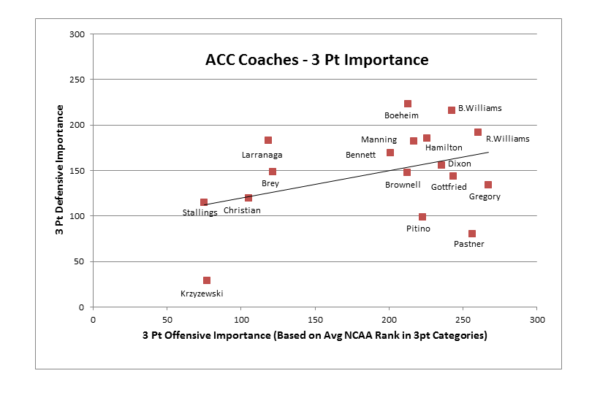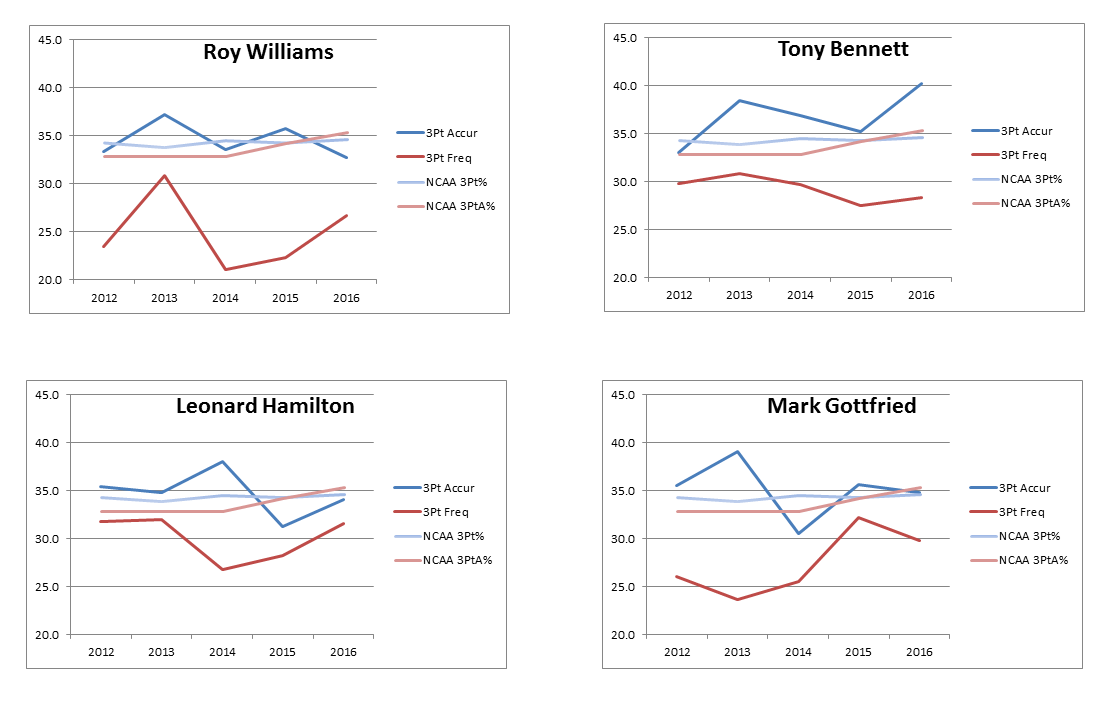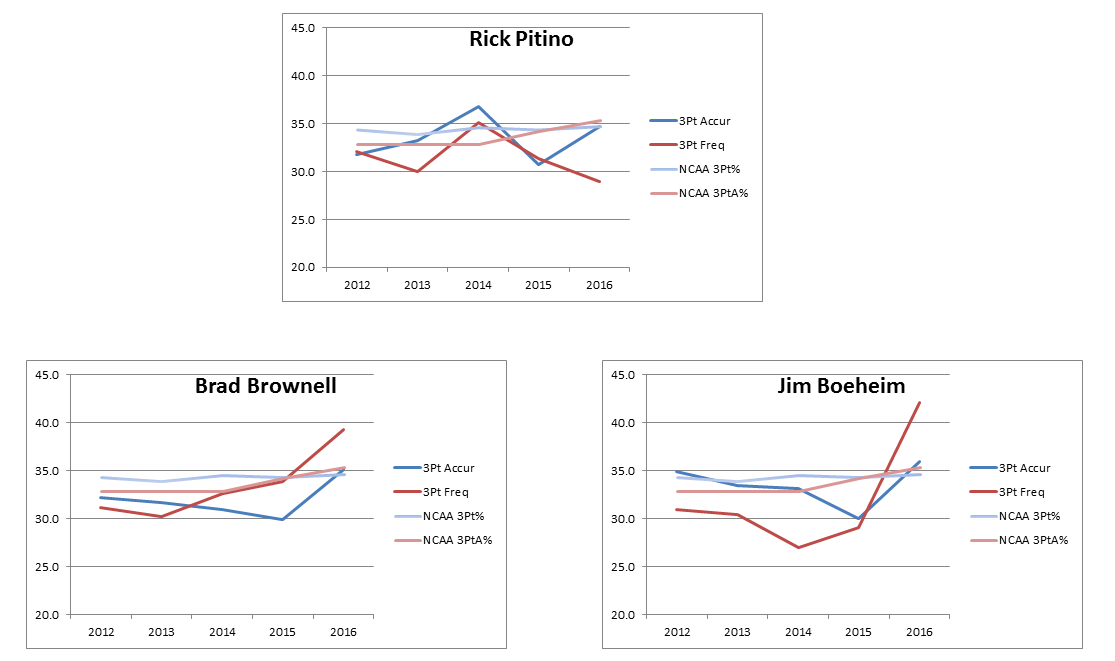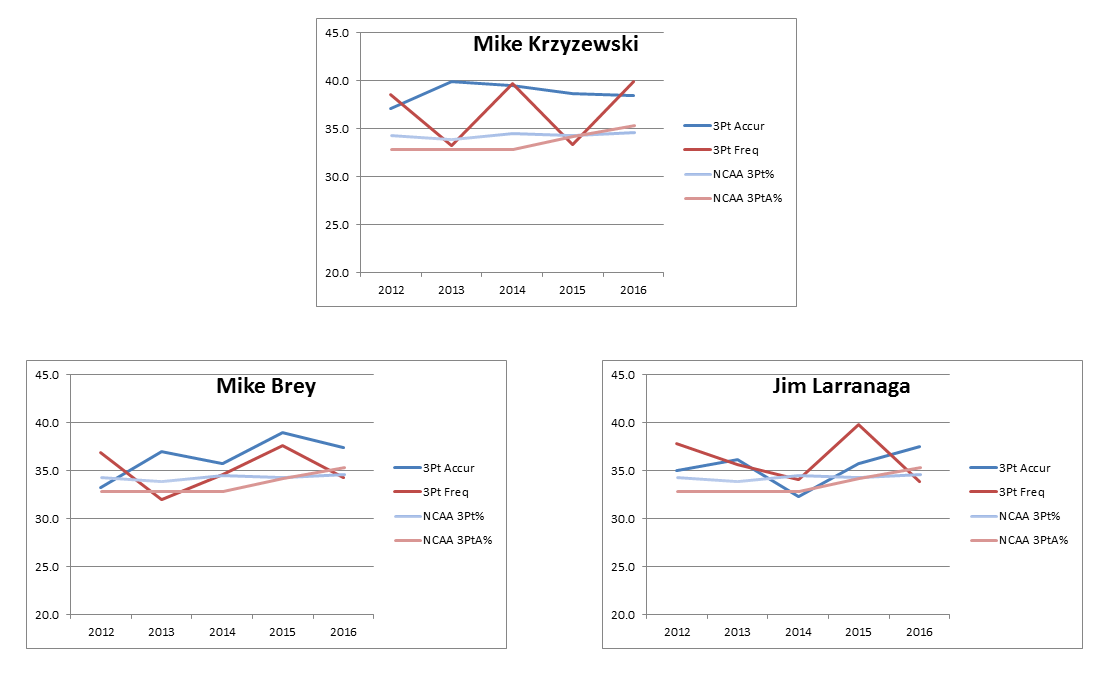ACC Trends: The Rise of Three-Point Shooting, Part II
Posted by Brad Jenkins (@bradjenk) on December 22nd, 2016In Part I of this series published earlier this week, we examined the latest stylistic change in college basketball: a substantial surge in three-point shooting. Players in both the NBA and college basketball are hoisting and making more long-range shots than ever before, a trend we expect to continue growing into the future. With that in mind, we decided to gauge how the 15 current ACC head coaches may be willing to adapt to such a shift in style of play. To make that assessment, we must first look at recent history. The graph above shows the relative importance of three-point shooting for ACC coaches over the past five seasons, both offensively and defensively. This rating is simply an average of how a coach’s team has ranked nationally in three areas concerning three-point shooting: three-point accuracy; three-point attempt percentage; and the percentage of points derived from three-point baskets. With only one exception — Wake Forest head coach Danny Manning has only four years under his belt — we used data from the last five seasons for each coach, including seasons at other schools (i.e., Josh Pastner at Memphis and Kevin Stallings at Vanderbilt).
The graph above shows the relative importance of three-point shooting for ACC coaches over the past five seasons, both offensively and defensively. This rating is simply an average of how a coach’s team has ranked nationally in three areas concerning three-point shooting: three-point accuracy; three-point attempt percentage; and the percentage of points derived from three-point baskets. With only one exception — Wake Forest head coach Danny Manning has only four years under his belt — we used data from the last five seasons for each coach, including seasons at other schools (i.e., Josh Pastner at Memphis and Kevin Stallings at Vanderbilt).
The trend line shows that ACC coaches are slightly more concerned with defending the three-point line than they are with making it. It also reveals that the league’s most successful coaches have very different approaches to the three-point shot. It has clearly been more important to Duke’s Mike Krzyzewski (lower left corner) than it has been to his conference brethren, especially on the defensive end of the floor. Contrastingly, North Carolina’s Roy Williams (upper right corner) may be the ACC coach least concerned with the three-point game, with Syracuse’s Jim Boeheim also trending in that direction. Rick Pitino‘s offense at Louisville doesn’t appear to rely on the long ball, but defending it is clearly a priority for the Cardinals. Interestingly enough, Pitino was among the first few major college coaches in the late 1980s to recognize the potential of the three-point shot. His 1987 Providence team (led by Billy Donovan) used the equalizing nature of the three-point shot to make a surprising run to the Final Four in the NCAA’s inaugural season with the shot. But much like Boeheim, Pitino has recently recruited with more of an eye on players that fit his defensive system.
With regard to the two ACC schools with new coaches this season, only one is seeing much of a stylistic change. Like his predecessor Brian Gregory, Pastner at Georgia Tech mimics Pitino’s approach: keep your own and your opponents’ three-point totals low — so far, the Yellow Jackets rank among the bottom 10 nationally in points from threes as a share of total scoring, and are second to last in taking only 20.2 percent of their total shots from three-point range. Pittsburgh fans, however, are seeing a bigger shift in philosophy since Stallings places greater emphasis on long distance shooting than longtime Panthers head coach Jamie Dixon ever did — although perhaps not exhibited in quite as much of a jump this season (from 31 to 37 percent of all shots) as it will eventually become.
Next we will examine how the ACC’s tenured coaches have used the three-point shot over the past five seasons. In the graphs below, the three-point numbers of the 10 ACC coaches who have been with the same school for the last five years are compared with the national averages. That group of 10 can be placed into three distinct groups. Let’s call the first group the “I don’t want to shoot threes and you can’t make me” group.
The four squads coached by this quartet of veterans never approaches the NCAA average for three-point attempts, even in seasons when their teams are making a high percentage of attempts. In fact, Florida State (Hamilton) and NC State (Gottfried) shot their least number of threes of the five-year window in the same year that they also shot their best percentage from deep. Of course, North Carolina (Williams) and Virginia (Bennett) have been doing just fine without making long distance shooting a key part of their offensive strategies. The key question for these coaches and their corresponding programs is whether they can continue to be so effective in the future using the same philosophy. As an increasing number of high school players become enamored with bombing away from distance at the expense of other parts of the game — call it the Stephen Curry effect — will the talent pool start to dry up for programs that have relied more heavily on two-point scoring? The second group of coaches shown below may be a bit more adaptable.
The three-point shot is generally not a huge part of their offenses but they are willing to shoot more threes when their teams can make them. For example, Clemson and Syracuse last season made a much higher percentage of their three-point shots than they had in recent years. Correspondingly, Brad Brownell and Boeheim gave their shooters the green light — the only time in this five-year window that either program has been above the national average in three-point attempts. If there are more good shooters coming to college and schools like Louisville, Clemson and Syracuse are able to snag some, expect this group to be ready and willing to incorporate more outside shooting into their attacks. Finally, the three ACC head coaches who may be ahead of the curve on this topic are shown below.
It’s not just that Duke, Notre Dame and Miami (FL) like to fire away from deep (although they all are usually above the NCAA norm for attempts); it’s that they almost always maintain a high degree of accuracy from behind the three-point line. For example, Krzyzewski seems to be comfortable with his team shooting threes at whatever rate works to keep its accuracy rate in the high 30s. Likewise, Mike Brey‘s teams consistently make a high percentage of their three-point shots, but the Irish’s accuracy and frequency lines appear to be very closely related. As for Jim Larranaga, it’s worth noting that his graph is somewhat distorted because of a 2014 season where he was replacing his top six players from the 2013 ACC champs. Therefore, that season’s data is far less indicative of the head coach’s normal offensive philosophy.
Through the first month of the 2016-17 campaign, there hasn’t been any drastic philosophical changes among ACC teams concerning three-point shooting. But it will be interesting to see what happens as the Curry Effect takes greater hold among future prep stars and which teams adapt most effectively as the game evolves away from the paint.













































